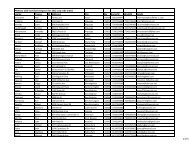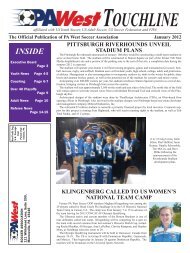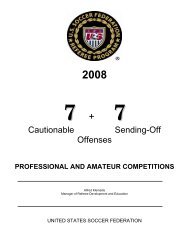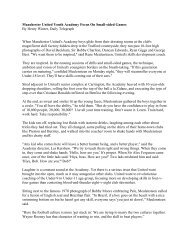pa west august 2004 - PA West Soccer Association
pa west august 2004 - PA West Soccer Association
pa west august 2004 - PA West Soccer Association
You also want an ePaper? Increase the reach of your titles
YUMPU automatically turns print PDFs into web optimized ePapers that Google loves.
August <strong>2004</strong> Page 19<br />
WE’RE ALL IN THIS<br />
TOGETHER<br />
There’s a brochure available from US Youth <strong>Soccer</strong><br />
titled “We’re All In This Together” and it highlights the fact<br />
that players, <strong>pa</strong>rents, coaches and referees must all work<br />
together to provide our kids with a game. The brochure<br />
emphasizes providing our players with a good playing<br />
experience.<br />
But “we’re all in this together” goes beyond coaches,<br />
Tim<br />
McCoy<br />
Director of<br />
Member<br />
Services<br />
<strong>pa</strong>rents and referees working together with good sideline behavior, quality refereeing,<br />
first-rate coaching and all the other trappings of playing the game. The administrators<br />
and governing organizations from the various realms of the game are “in<br />
it together” as well.<br />
At the conclusion of the second weekend of the Chevy Open I was talking to a<br />
long-time soccer enthusiast who’s been involved in the game for years. His experience<br />
has been at levels from youth to the pros and everything in between.<br />
During our conversation, he offered a bit of insight that was telling and crucial<br />
to soccer’s growth and at some levels existence. He shared that soccer is too fragmented<br />
in <strong>west</strong>ern Pennsylvania, not to mention the United States. There are too<br />
many levels and organizations looking out for themselves and not the game. He<br />
cited opportunities missed because those involved were more worried about their<br />
own organization than the bigger picture.<br />
Ego plays a big <strong>pa</strong>rt in these missed opportunities; personal beliefs and goals<br />
have clouded viewpoints. But there are other reasons for the fragmentation,<br />
including poor leadership, lack of vision, and failure to plan. And the document<br />
that governs the United States plays more than a small role in our fragmentation.<br />
Before all you <strong>pa</strong>triots get too upset, I’ll explain how our Constitution plays a<br />
role here. Through our country’s governance, the US <strong>Soccer</strong> Federation isn’t the<br />
end-all, be-all of soccer that it would be in other countries. Unlike England, where<br />
the FA decides all things soccer, US <strong>Soccer</strong> cannot govern with the single purpose<br />
of what’s best for the sport, but must accommodate any organization interested in<br />
affiliating or associating with it. USSF answers to the US Olympic Committee in<br />
accordance with their guidelines and the US Constitution.<br />
Giving everyone equal rights is great when it comes to jobs, voting, serving in<br />
the military and the essentials of living our lives, but when we’re talking about a<br />
game, having to accommodate too many special interests makes it very difficult to<br />
focus on game.<br />
All too often, I get phone calls or emails from a person or group interested in<br />
forming a club. The purpose for forming the club isn’t because there’s a need, so<br />
much as it’s a desire. The person or persons involved usually has a level of dissatisfaction<br />
with their current club. Fortunately, our regular clubs must have geographic<br />
boundaries and our Constitution and Bylaws currently prohibits more than<br />
one club in the same geographic boundary. But in the case of classic organizations,<br />
because we can’t discriminate, a newly formed club that meets our criteria for<br />
membership, should be accepted. In the “old” days, dissatisfaction among the<br />
membership would have prompted changes in leadership, but today, it’s easier to<br />
leave and form a new club. This “waters down” the teams and league competition.<br />
This same dance occurs at the Federation. A group of individuals or clubs can<br />
decide to form a new organization… their goals might be diametrically opposed to<br />
the mission of USSF, but if they meet the membership requirement they have to be<br />
accepted. Even if they’re only forming their organization for the purpose of cashing<br />
in on the boom in youth sports their affiliation must be accepted.<br />
So where do we start? We have to look toward building bridges and fostering<br />
good relationships. From the local level of clubs working together, to the state<br />
level with those at odds with one another deciding to work together instead of<br />
against one another. We also have to work more closely with our pro teams and<br />
our national organizations.<br />
Locally, I think we have to realistically look at our current structure and decide<br />
whether it is in need of an overhaul or minor changes. Our Restructuring and<br />
Reorganization Committee is currently working on this project and the results<br />
should be out soon.<br />
Youth sports have evolved into big business and our association has to recognize<br />
this, not just those individuals sitting on the various boards and committees, but<br />
also our club leaders. What does this mean? We have to understand that kids and<br />
their <strong>pa</strong>rents are no longer just looking for a place to play; they’re buying a service<br />
and they expect it to meet their expectations. They have greater expectations,<br />
more sophisticated needs; they want to belong to a club that provides not just a<br />
game, but a learning environment that goes beyond just kicking a ball.<br />
This could mean a competitive environment for the clubs. The clubs with the<br />
best training programs attract more players, better players, and continue to grow.<br />
Those clubs resting on their laurels or unwilling to work to meet the demands of<br />
the soccer marketplace will be left behind. It might mean clubs working together<br />
to offer teams for Division 1, while keeping their own Division 2 or 3 team(s). It<br />
Support Our Sponsors:<br />
TOUCHLINE<br />
might also mean smaller clubs merging to create bigger<br />
clubs that will have a membership enabling the club to create<br />
teams in more than one level per age group.<br />
I’ve written before about clubs helping each other and<br />
how each level can only be as good as the level below<br />
them. At the club levels this would be a great way to start.<br />
Imagine neighboring clubs putting aside their school or<br />
geographic rivalry to help each improve, one’s referee<br />
numbers and quality increases while the other learns more<br />
about volunteer recruitment. Maybe a classic club would<br />
help improve the coaching and player development programs in a regular club.<br />
This cooperation helps grow the game.<br />
The growth is beyond the basic elements that each helps the other address.<br />
There’s a relationship built that can be drawn upon in the future. Maybe a joint<br />
effort on fields or a combined purchasing agreement will be the next collective<br />
effort. It also helps each club increase its potential for fulfilling the needs and<br />
expectations of their members.<br />
My friend also shared that due to ego, protecting turf, or just an unwillingness<br />
or inability to see beyond the needs of the organization, soccer as a whole suffers<br />
because cooperation doesn’t exist as it should.<br />
I attended a coaching seminar conducted by US Youth <strong>Soccer</strong> Assistant Director<br />
of Coaching Sam Snow and he offered that change can be done from within or<br />
without a club. Usually, change from within is more effective and less upsetting,<br />
while change from the outside is destructive and usually means the benefits won’t<br />
be good, especially in the short term.<br />
I think it was about this time last year I pointed out that <strong>PA</strong> <strong>West</strong> <strong>Soccer</strong> was<br />
beginning to make nice strides forward! We had dramatically increased the number<br />
of players involved in the Region 1 ODP pools to 16.<br />
I opined that it was because of the efforts our Coaching and Player Development<br />
programs were making. We had started a number of programs offered by <strong>PA</strong> <strong>West</strong><br />
<strong>Soccer</strong> and encouraged our clubs to become more involved in developing players<br />
and coaches. In reflecting upon that article, I realize now what I failed to recognize<br />
then, that while <strong>PA</strong> <strong>West</strong> <strong>Soccer</strong> was showing improvement, other portions of<br />
our game weren’t benefiting from our good fortune.<br />
While we were beginning to show growth, the Riverhounds were on final<br />
approach for a move down from the A-League. The team was achieving great success<br />
on the field under Ricardo Irribarren but attendance figures didn’t reflect the<br />
on-field success and couldn’t support a budget for the A-League, so this year<br />
they’ve moved down to the Pro <strong>Soccer</strong> League. The two organizations failed to<br />
develop a plan to help each other grow the game. We needed to develop a plan<br />
beyond trying to entice fans to attend a game or two, but something meaningful<br />
that would prove we’re in it together.<br />
You’ve heard the mantra, “a successful pro team gives kids role models to imitate<br />
and team for which a child can strive to play.” But having pro soccer in your<br />
community goes beyond an occasional night out, it indicates the sport has some<br />
legs in your area. The media and government has to <strong>pa</strong>y attention to what the soccer<br />
community is doing. It also gives the game a multi-pronged attack when seeking<br />
support for programs and projects. There’s strength in numbers, especially<br />
when dealing with politicians.<br />
It’s not an accident that the Pittsburgh Penguins are having more trouble getting<br />
public money for a new arena than the Pirates or Steelers did. How many kids play<br />
hockey com<strong>pa</strong>red to baseball or football? While the public coffers are empty, if<br />
roles had been reversed and either the Pirates or Steelers were currently looking for<br />
support for a new facility every politician would be looking for proverbial nickels<br />
in their office couch because the numbers have it. <strong>Soccer</strong> needs to use its strength<br />
of numbers to its advantage.<br />
Only basketball ranks ahead of soccer among <strong>pa</strong>rtici<strong>pa</strong>tion for team sports<br />
according to the Sporting Goods Manufacturing <strong>Association</strong>. This gives our sport<br />
tremendous strength whether your club is negotiating field time with a school or<br />
trying to get a grant for field improvement or development from politicians. But<br />
if our pro team goes away the sport’s presence is diminished.<br />
At the national level there’s also problems because USSF has been unable to get<br />
all its affiliates to “buy into” its plan for the game. Those involved each believe<br />
they have a better plan to achieve the same goal. There’s usually more than one<br />
way to do a job, but when all <strong>pa</strong>rts are pulling in different directions the job won’t<br />
be finished as effectively or efficiently.<br />
If we’re fractionalized…we’re not as strong. We can’t develop players or teams<br />
like we should; the entire sport suffers. We can’t help the game achieve the status<br />
it should. We must find ways to set our differences aside and pull together. We<br />
have to ask questions of our leaders, from club to USSF, how do we all get on the<br />
same <strong>pa</strong>ge? What are our needs and how do we address them? Is any one program<br />
more important than another? What’s our plan for our club, for our state, for our<br />
national organizations and do these plans all have common goals? Everyone working<br />
for the same goal is the only option because we’re all in this together.
















